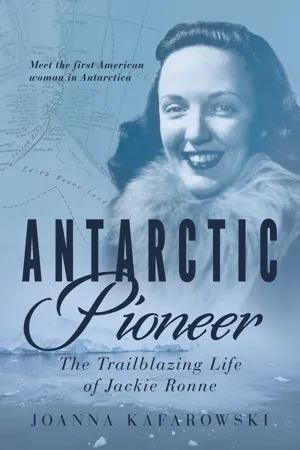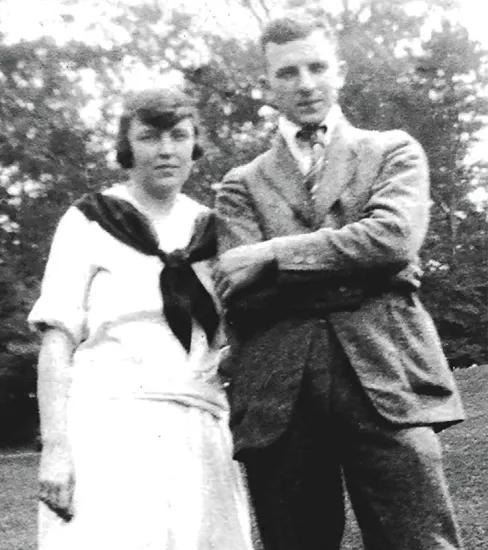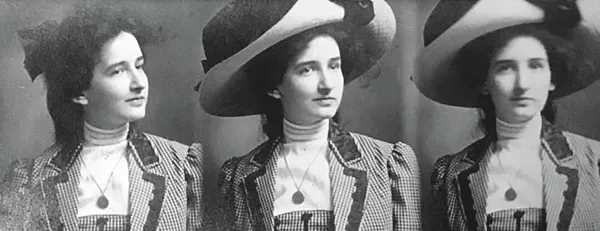![]()
PART ONE
BEFORE ANTARCTICA
![]()
CHAPTER 1
OVERCOMING THE ODDS
Not how you are, but what you make of things.
— NORWEGIAN PROVERB
CHURNING THROUGH THE frigid billowing waves, the battered Zodiac sped straight and true toward tiny Stonington Island in Antarctica. On board, her heart filled with trepidation and her eyes fixed on the approaching shore, was polar icon Jackie Ronne and daughter Karen. Almost fifty years previously, Jackie had been the first American woman to participate in an Antarctic expedition, and one of two daring women to overwinter on the continent. It was now February 1995 and this momentous trip to East Base on Stonington Island was her first visit back in decades. She had never intended to return, but fate had intervened. The thirteen months she had spent there in the company of her husband, famed polar explorer Finn Ronne, and the twenty-two-member expedition team had been challenging, fraught with tension — and the highlight of her life. Years later, her husband and most of the expedition members were dead and Jackie was beginning to receive the recognition she deserved.
Reaching the pebbled beach, the two excited women and their friend, photographer Ann Hawthorne, were assisted out of the bobbing boat and scrambled awkwardly onshore. The M/V Explorer, operated by luxury cruise specialist Abercrombie & Kent, was anchored a kilometre and a half away with ninety-two guests eager for their turn to visit the island. Thankfully, everyone waited respectfully for Jackie to have time there with Karen. It was a laborious, slow climb to East Base, with snowdrifts up to their waist in some areas, but nothing was going to stop them now. Hawthorne remembered how important it was to get Jackie to the base: “It was a walk of discovery back in time.” Finally, as skuas dived and careened about their heads, Jackie stood in the clearing of buildings that represented the most momentous part of her life — her time as a member of the 1946–1948 Ronne Antarctic Research Expedition.
The tiny 3.5 x 3.5–metre Ronne Hut in which she and Finn had lived and worked was still there, in a dilapidated state. Jackie had to climb on a pillar of stones to peer through the dirty, streaked window that Finn had installed for her. She was flooded with emotions — excitement at visiting this remote place from her past and sorrow because Finn was not there to share it with her. She and Karen wandered the few steps over to the wooden bunkhouse, with its plaque declaring East Base as a protected heritage site, and then surveyed the foundations of the machine shop, which had been demolished in the intervening years. Lastly, she and Karen entered the science building where the men had conducted their experiments. She was dismayed by the condition — the creeping mould on the wood and the missing panels on the roof. There was evidence of decay everywhere. So much had changed and most of the equipment and furnishings inside the buildings had been stolen, removed, or destroyed.
Karen knew all the exciting stories, but how wonderful to hear them again from her mother in situ, where the historic expedition had taken place. This was where Jackie Ronne’s lifelong obsession with Antarctica had come to life and where her role as a pioneer had originated. Karen later commented: “She didn’t see herself as a feminist icon who did unusual, difficult things. She thought she was caught up and swept along by events and ended up becoming famous for going to the Antarctic. She didn’t set out to be a rebel.”
While her friend Arctic explorer Louise Arner Boyd had yearned to visit the frozen wastelands of the polar pack ice since she was a child, Jackie Ronne (born Edith Maslin) had hardly even heard of Antarctica until she was a teen. History-making in Antarctica — the intense, international competition to be the first to reach the South Pole; the tragedy of the lost lives of desperate heroes; the stark beauty of this desolate continent — was of no real interest to her. It existed in a separate reality from her own. She grew up as an ordinary American girl with a normal, if rather dysfunctional, family. Despite her unremarkable beginnings, Jackie always felt in her bones that she was meant for something extraordinary. Her destiny, to be an Antarctic pioneer, would not be revealed for years to come.
As a cool dawn broke on the morning of October 14, 1919, twenty-three-year-old Elizabeth Parlett Maslin lay in a Maryland General Hospital maternity room in Baltimore, recovering from the travails of birthing her daughter the previous night. A conventional woman of her time, she bestowed two of the most popular names of the year on her daughter: “Edith” and “Anna.”
Less than five months earlier, Elizabeth had married strapping twenty-one-year-old Charles Jackson Maslin in a shotgun wedding. Daughter Edith Maslin’s first home was in rental accommodations at 1917 Eutaw Place in a genteel Baltimore neighbourhood. While her parents lived there, it was described as “a broad and lovely avenue of fountains and plants and promenades, its twelve blocks from Dolphin Street to Lake Drive a ribbon of elegance.” It is still an attractive area today. The community was dominated by towering Victorian mansions originally inhabited by some of the city’s colourful characters, including William Van-Lear Black, millionaire publisher, aviator, and sponsor of Richard Byrd’s 1926 flight to the North Pole.
Many immigrant families lived in the area nearby, seeking the American dream. The houses there were sprawling, bustling places, frequently inhabited by two or three families. The Maslins’ apartment was located in the biggest and noisiest house of all: 1917 Eutaw Place was home to six families. In total, nineteen people lived in the house. There was no privacy or quiet time to be had there. Still, if their actual home left something to be desired in terms of peace and tranquility, the proud young parents would have enjoyed the short walk to leafy Druid Hill Park and Druid Lake — the crown jewel of parks in Baltimore, which offered space for recreation and quiet reflection.
Elizabeth Parlett and Charles Jackson Maslin, likely in 1918.
Merriel Pratt Maslin, likely in 1915.
Later in life, Edith would learn about other famous Baltimore residents who lived there around the same time. Streets away in Upper Fells Point, a mainly Black neighbourhood, the little girl who grew up to become the smoky-voiced jazz singer “Lady Day” Billie Holiday had spent a troubled childhood being shunted from one reluctant relative to another. One of the greatest American sports heroes of all time, Babe Ruth, was born and attended a reformatory there before he left to join the Boston Red Sox in 1914. Mystery writer Dashiell Hammett of The Maltese Falcon and Sam Spade fame probed the seedy underbelly of Baltimore while working for the Pinkerton Detective Agency.
With wavy, dark-brown hair framing a rounded face and wide-set eyes, Elizabeth had a lively rather than a beautiful face. In an early photograph, she looks squarely at the camera with hope and determination. Almost but not quite as tall as her new husband, she had worked as a clerk but gave this up after marriage. Jackie recalled that her mother could be a taskmaster where her homework was concerned and should have been a teacher. Images of Charles Jackson Maslin show him impeccably dressed in a dapper suit and hat. He is boyishly handsome, with a remarkable resemblance to the young writer F. Scott Fitzgerald. Hair slicked smartly back, tie pulled neatly into place, he was a young man with great things ahead of him, or so his young bride must have hoped.
Elizabeth Parlett Maslin was descended from an early Baltimore family that had immigrated from England in the early eighteenth century. There have been generations of Parletts living in Baltimore ever since. The 1901 R. Polk Directory for Baltimore lists over fifty Parletts, including a spiritualist, a president of a cigar factory, a horse-shoer, and a tax collector. In the year Elizabeth was born, the list included a munitions worker, a president of a middy blouse manufacturer, and a thirty-four-year-old policeman named Daniel H. Parlett, Elizabeth’s father.
Young Elizabeth grew up in a turbulent home, and in 1903, when she was seven years old, her mother sued her father for divorce on the grounds of brutality. This was a dramatic step by a woman with two young children. It would have caused a scandal within her family and community, and was a stigma that Elizabeth struggled with. After the divorce, Elizabeth moved with her mother into the home of her maternal grandmother. As was the case with many divorced women of the time, their quality of life suffered. On the other hand, Daniel Parlett, a fifteen-year veteran of the Baltimore Police Force, started a second family and was financially secure all his life. There is little evidence to suggest that her father or her paternal family ever played a major role in Elizabeth’s life.
Elizabeth’s young husband, Charles Jackson Maslin, had a distinguished lineage on his mother’s side, as he was descended from soldiers who fought in the American Revolution. His parents, Edith Pratt Maslin and Samuel Jackson Maslin, moved from Havre de Grace, Maryland, to Baltimore soon after their marriage. They had two children: a daughter, Merriel Pratt, born in 1895 and a son, Charles Jackson, born two years later. The siblings were close and Merriel always harboured a strong sense of responsibility for her younger brother. The Maslin family played a critical role in the life of young Edith. Edith’s paternal grandparents were upstanding Baltimore citizens who took their civic responsibilities seriously. Edith’s grandfather worked as a grocer who gave freely of his time to local volunteer organizations. He and his wife were high-minded, steady, and conscientious, and raised their two children to be the same.
Merriel was an unusual woman and became one of the most influential people in Edith’s life. Strong-minded and straight as an arrow, Merriel was a Peabody Scholarship recipient and a dedicated physics student at the all-women’s Goucher College. At this time, there were few women physicists in the United States and only a handful found jobs in their field. Merriel, however, was determined and became one of the first women physicists to work for the National Bureau of Standards. It is not known if young Merriel was conflicted regarding marrying and starting a family or having a career. Few women scientists were allowed to combine the two. Perhaps she agreed with Florence Watts, who reported that she intended to remain single because “I have other professions open to me in which the hours are shorter, the work more agreeable and the pay possibly better.” By the time her niece Edith was born, Merriel had proven herself to be accomplished, hard-working, and successful. Sadly, the same could not be said of Charles, her younger brother and Edith’s father.
From the beginning, Charles lacked the steadiness and focus of his sister. By the time he was twenty, he had a questionable employment record. Never keeping a job for long, he shifted between one position and the next. Charles’s fallback was always working in his father’s grocery, where his father kept an eye on him. When his daughter was born, he worked as an inspector for stove manufacturer Bartlett-Hayward, although this job, too, was short-lived. His lack of ambition and self-discipline would impact on his marriage and the upbringing of Edith. It would also influence the type of man she would later look for as a husband.
As a new wife and mother, Elizabeth Maslin struggled to provide for her child and husband. Strikes were rife across the country — food and coal shortages were the scourge of every household. Food prices skyrocketed. In 1919 Elizabeth would have paid about $660 for her yearly food bill, compared to $380 only three years previously. Having a father-in-law who was a grocer certainly helped.
Growing up a few minutes away from her paternal grandparents in an affluent neighbourhood would have seemed to offer an ideal start to the life of any child. But Edith’s world was not as safe and insulated as might be expected. The civil unrest in the United States after the war was experienced in most cities across the country, including Baltimore. Only weeks before she was born, Baltimore residents witnessed a violent race riot. Any young family strolling through Druid Hill Park would know that playgrounds, swimming pools, tennis courts, golf courses, and dance pavilions, in short, anywhere one would want to go in the park, had been racially segregated since the park opened in 1860 and would remain so until the mid-1950s.
Injustice was apparent within other sectors of society, too. Changes in the status of American women were underway. In the summer of 1919, the United States was in the throes of a divisive battle over the rights of women, provoking strife within households and the community alike. The struggle for a woman’s right to vote had been raging for years, but, at long last, the end was finally in sight. In 1916, Alice Paul and Lucy Burns had formed the National Woman’s Party as an outgrowth of the National American Woman Suffrage Association. Since that time, relentless pressure on the government had moved the dial. The election of Jeannette Rankin as the first woman member of Congress was a gamechanger. In June 1919, Congress passed the Nineteenth Amendment: “The right of citizens of the United States to vote shall not be denied or abridged by the United States or by any State on account of sex.” This amendment was ratified the following year.
Following the passage of the Nineteenth Amendment, women across the country were jubilant, anticipating change across all spheres of life. Politicians feared a “petticoat hierarchy which may at will upset all orderly slates and commit undreamed of executions at the polls.” Women reformers were successful in proposing the 1922 Cable Act, which improved the citizenship requirements for married women, and the 1924 Child Labor Amendment addressing the federal regulation of child labour, but this success was diminished when women’s groups splintered due to differences regarding strategy and objectives. During the week following Edith’s birth, Elizabeth Maslin would have read in the Baltimore Sun about the plans for a new Woman’s Clinic at the local Johns Hopkins Hospital as well as the nationwide drive on the part of women to support the newly forming League of Nations. Despite all of this, the position of ordinary American women like Elizabeth Maslin did not seem to change much in the household and in the workplace — but the wheels were turning.
The social disquiet that pervaded the country and the city of Baltimore was reflected in the Maslin household. Charles was prone to depression and emotional turmoil, and as a result, he had difficulty holding down a job for any length of time. Needless to say, this re...



